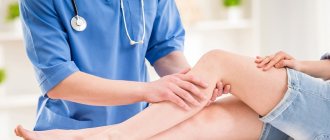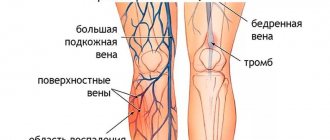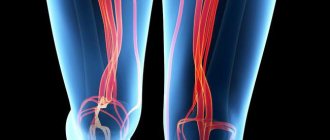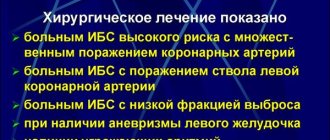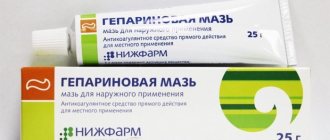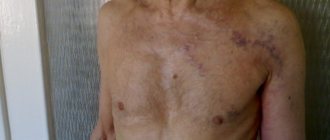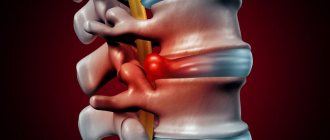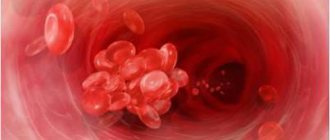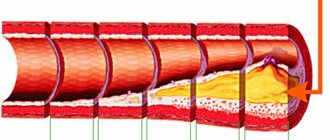Recommendations for patients with varicose veins
There are several simple recommendations for varicose veins, the observance of which is necessary for a patient with a disease of the venous system and significantly alleviates the condition and reduces the risk of developing complications of varicose veins:
- Use compression stockings. This is the best means of preventing and treating various manifestations of venous insufficiency.
- Elastic bandaging improves blood circulation in the legs by 2-3 times. Bandaging is performed in a horizontal position of the body from the toes and above to the knee joint (in no case vice versa). Each round of bandage covers the previous one by half. You can wear elastic stockings or tights, which should also be worn horizontally.
- Keep your legs elevated while sleeping or resting.
- Regularly shower your feet with a tight contrast shower, alternating warm and cool water.
- If, due to your profession, you are forced to sit or stand for a long time, change the position of your legs more often, and walk at a fast pace from time to time.
- Wear shoes with medium heels (no higher than 3-4 cm).
- Exercise regularly. Walking has a beneficial effect on the veins, during which the leg muscles actively work, helping the movement of blood through the veins. However, everything in moderation: hiking is contraindicated. If you like recreational running, do not jog on concrete or asphalt tracks: the shock load on the foot increases tension in the veins. Lay the treadmill on grass, sand, or soft soil. Swimming is the most optimal, since the body is in an unloading - horizontal position, and water pressure tones and naturally stabilizes blood vessels. Swimmers practically do not have varicose veins. Avoid sports that put a lot of stress on your legs (tennis, weightlifting, high jumping). Avoid taking too hot baths, visiting a sauna, or prolonged exposure to the sun.
- Varicose veins worsen and often appear for the first time during pregnancy, and therefore pregnant women must follow recommendations aimed at preventing varicose veins.
- If you are prone to varicose veins, you should not wear socks and knee socks with tight elastic bands. They can obstruct the flow of blood from the superficial veins.
- The development of varicose veins is facilitated by concomitant diseases - obesity (excess weight increases the load on the veins), flat feet, prolapse of internal organs.
This article has been read 4,589 times.
Why you need to treat varicose veins
Varicose veins are a disease of people in “standing” professions: sellers, hairdressers, machine operators, surgeons and anyone whose professional duties require prolonged static load on the lower limbs. It is under conditions of static load that the venous valves that regulate the inflow and outflow of blood in this area of the body weaken. As a result, the blood in the veins stagnates and thickens, stretching and deforming the walls of blood vessels - creating the preconditions for the appearance of varicose veins.
The process develops slowly, and at first the sick person believes that he does not have varicose veins in his legs if he does not notice severe swelling and bumpy bluish strands protruding under the skin. But this picture is typical only for an advanced stage, when the only way to restore the normal appearance of the lower extremities is a surgical scalpel. However, the main danger of varicose veins is not that the legs hurt, swell and lose their attractiveness, becoming covered with knotty vessels protruding above the surface of the skin.
By causing stagnation of blood flow, varicose veins provoke the formation of blood clots in the vessels of the legs - viscous dense clots consisting of red blood cells (blood cells). Through the flow of blood, blood clots spread throughout the body, enter the lungs, heart, brain, blocking the vessels supplying them with blood, and leading to thromboembolism - blockage of the vascular lumen, which can result in severe pathologies:
- Myocardial infarction – death of heart muscle tissue due to lack of blood supply;
- Stroke is an acute disorder of cerebral circulation that causes the death of brain cells;
- Gangrene is tissue necrosis.
Attention!
Any of the ailments described above results in at least severe disability and, at maximum, death. Therefore, varicose veins should not be started under any circumstances.
The patient should consult a doctor when the first signs of the disease appear:
- Rapid leg fatigue;
- Nagging pain in the legs, especially at the end of the day, or after physical activity;
- Goosebumps - it’s as if the leg was “served”;
- Small vascular networks and “stars” protruding on the surface of the skin of the legs;
- Leg muscle cramps (usually at night);
- Swelling of the legs.
Primary symptoms of varicose veins
With timely measures taken, modern methods of treating varicose veins on the legs make it possible to prevent the progression of the disease and reverse the process. Now this can be done without resorting to highly traumatic surgical operations, which previously were the only way to solve the problem. Doctors know many procedures for treating varicose veins that can provide the patient with the opportunity to return to their normal lifestyle.
Laser and radiofrequency ablation
Among the modern methods of treating varicose veins, an outpatient laser ablation procedure is distinguished. Such therapy can last from 30 minutes to 2 hours. One of the advantages of the procedure is the patient’s ability to return home independently without the help of an accompanying person.
A special light conductor is inserted into the vein and guided deep into the vein, then the laser is turned on and the wire is removed from the damaged area. Thanks to the laser, the blood begins to clot and the vessels quickly stick together. The slight tension disappears over time.
The following conductors are distinguished:
- for the treatment of veins no wider than 1 cm, use the butt one;
- Wider coverage is provided by a radial light guide.
Modern treatments for varicose veins also offer radiofrequency ablation. This method is less traumatic. During the process, the doctor administers anesthesia and makes a puncture in the vein to insert a catheter. Then an anesthetic is released, creating a water feather bed that protects muscle tissue and blood vessels.
The latter method restores the patient’s active physical activity after 15 days.
Treatment of varicose veins
There are two main methods of treating varicose veins:
- conservative,
- operational.
The type of treatment depends on the stage of the disease. In patients with lesions of small caliber veins in the form of vascular networks or asterisks on the legs, as well as with isolated local lesions of some saphenous veins, non-surgical methods are used.
In case of damage to large trunks of the saphenous veins, such as the great or small saphenous vein, as well as their large tributaries on the thigh and lower leg, surgical techniques are used.
Compression jersey for the treatment of varicose veins, photo
At an early stage, varicose veins can be treated with compression stockings.
This is a special type of therapeutic clothing that can prevent stagnation of blood in the veins by applying the necessary pressure to the area of the body where the diseased vein passes. Therapeutic underwear maintains the tone of the veins, compresses them and pushes the blood upward, preventing it from stagnating. Such stockings, knee socks, socks, tights are made from elastic materials. Microfiber, nylon, lycra, and cotton are used for medicinal purposes. Products are made without seams. They have different sizes, so each patient will be able to choose the necessary products for himself. Each product has its own marking. For treatment and prevention, compression garments are used, marked from I KCl to IV KCl (from light compression to very strong). Compression hosiery for varicose veins should be worn not when ulcers cover the legs, but when swelling has just appeared, swelling has become noticeable, and leg fatigue is felt more than usual in the evening.
Varicose veins treatment. Conservative therapy
To the first group
conservative treatment applies. This type of therapy is used at all stages of varicose veins. It should be noted that in advanced stages of varicose veins, conservative therapy only complements the main treatment method: surgery, any endovenous innovative procedure or sclerotherapy (scleroobliteration).
Modern conservative treatment is aimed at strengthening the venous wall, eliminating venous stagnation and relieving the symptoms of chronic venous insufficiency (CVI). This group of treatment for varicose veins includes: phlebotonics (venotonic drugs), compression hosiery or compression bandages, variable pneumatic compression devices, electromyostimulators, manual lymphatic drainage massage procedures.
Phlebotonics and compression hosiery
Electromyostimulators and variable pneumatic compression devices
The main advantages of conservative methods are accessibility, the ability to carry out treatment at home, at a time convenient for the patient; you just need to consult a phlebologist. Conservative technologies have good therapeutic and preventive effects. Features of this treatment approach include:
- Conservative therapy, as a monotherapy, is effective only in the initial stages of the disease and for the prevention of varicose veins.
- In the presence of advanced forms of varicose veins of the lower extremities, such therapy is only complementary to more radical technologies.
Conservative treatment is successfully used by specialists from leading city phlebological centers and private clinics, as well as public hospitals in Moscow. Lastly, given the shortage of modern technologies, one can often note the disproportionate and unjustified use of conservative techniques. Perhaps the level of phlebological care in public health care could be significantly increased by improving interaction with good private medical centers. This applies not only to Moscow and the Moscow region, but also to any other region of our country.
Drug treatments for varicose veins of the legs
The traditional use of phlebotonic drugs has proven itself well. These include means of old and new generations:
- rutazoids (Troxevasin, Troxerutin);
- products containing diosmin and hesperidin (Normoven, Detralex, Phlebodia, Cyclo 3 fort);
- herbal preparations based on chestnut (Aescusan);
- vitamin combination preparations (Ascorbic acid, Ascorutin).
Drug therapy for varicose veins must include anticoagulant drugs and agents that improve blood rheology - acetylsalicylic acid and its derivatives (aspirin, cardiomagnyl, aspecard).
- Clopidogrel, Plavix, Trombonet;
- Pentoxifyline and its analogues (Pentilin, Trental, Vazonit);
- direct and indirect anticoagulants (Heparin, Fraxiparin, Clexane, Warfarin);
- prostaglandin drugs (Alprostan, Vazaprostan, Ilomedin) are prescribed only in severe cases of venous insufficiency, being a group of reserve methods for the treatment of varicose veins.
Local therapy includes the application of ointments, gels and creams to the affected area. They are based on anticoagulant and phlebotonic substances (Lioton gel, Venitan, Troxevasin, Heparin ointment).
With the development of inflammatory changes and trophic skin disorders, ointments based on glucocorticosteroids (Sinaflan, Kremgen, Trimistin) have proven themselves well.
Hirudotherapy - treatment with medicinal leeches - can also be useful.
Anti-varicose medications
Drugs prescribed for pathology are divided into several groups according to their mechanism of action:
- Antiplatelet agents . They are believed to reduce the risk of blood clots, but convincing scientific evidence is only available for their preventive effect on the formation of atherosclerotic plaques in the arteries. Aspirin (acetylsalicylic acid), Thrombo ACC, Cardiomagnyl.
- Venotonics . Strengthens the venous wall, reduces swelling. This is the most commonly used group of drugs. Phlebodia 600, Detralex, Venarus, Troxevasin.
- Anticoagulants . Heparin-based drugs thin the blood and are used to prevent and treat blood clots. They come in the form of tablets, injections and ointments. Xarelto, Clexane, Fraxiparine, Lyoton gel, Heparin ointment, Trombless.
- Angioprotectors and microcirculation correctors . Improves blood circulation, microcirculation and vascular condition. Troxerutin, Curantil, Detragel.
When complications occur in the form of trophic ulcers, healing agents such as Oflomelid, Solcoseryl and dressings for various purposes are used. Treatment of ulcers depends on the stage of the process, the extent of the tissue defect and other factors. In each situation, the treatment course is prescribed individually.
Drug treatment of varicose veins
Among the numerous pharmaceutical products, we highlight the main ones:
1. Gamma benzoperons
a) Diosmin (detralex, diovenor). The micronized form ensures excellent absorption and high effectiveness of the drugs. Their use helps suppress inflammatory processes inside blood vessels, reduce the permeability of venous walls and blood stagnation, increase the tone of the veins, improve tissue lymphatic drainage and blood microcirculation, and protect the venous endothelium from oxygen deficiency.
Latest information: Blood thinning with tablets and medications without aspirin
b) Butcher's broom extract (cyclo-3 fort) reduces capillary permeability and increases capillary resistance (resistance), has venotonic properties.
2. Rutin preparations (venoruton, troxerutin, troxevasin). This group of drugs has a venotonic and anti-edematous effect, reduces the fragility and permeability of capillaries, and also suppresses the formation of free radicals.
3. Saponins (aescusan, aescin - horse chestnut seed extract) have a pronounced capillary-protective, anti-inflammatory, decongestant and venotonic effect. In addition, this group of drugs gives a moderate anticoagulant (prevents blood clots) effect.
4. Pycnogenols (endothelon - grape seed extract) reduce capillary permeability and protect the endothelium of venous vessels, prevent vascular hypoxia, and have a venotonic effect.
5. Flavonoids (gincor fort) have an antihypoxic effect (increase oxygen supply), improve venous tone, venous return to the heart and blood fluidity. Contraindications: hyperthyroidism.
Pillow for varicose veins
More recently, they have learned to treat diseased veins using the Varifort varicose pillow. This unique device really resembles a small pillow that needs to be attached to sore limbs. There is another name for this same device - over the knee boots for varicose veins, since this device is attached to the legs in the form of a boot top. This medical device consists of two layers. The outer surface of the pillow is a two-layer fabric. The bottom layer is represented by a microsphere, which is covered with silicon-organic coating on top. It causes blood to circulate normally and restores the tone of diseased blood vessels. For ease of use, the anti-varicose pillow has Velcro.
General recommendations
Next, general recommendations on how to treat varicose veins. First of all, you should eliminate everything that interferes with normal blood circulation. If the nature of the work requires you to sit for a long time, the affected leg is placed in a horizontal position.
It is advisable to walk a little every hour and a half or climb up onto the slopes 10-15 times. The resulting muscle contractions improve blood circulation, increasing venous blood flow. The same exercises are recommended for those who work standing, but it is advisable to take breaks more often - every 45-50 minutes.
After work, the best rest for your legs is a slow, calm walk over short distances. Bandaging with an elastic bandage gives a good preventive effect.
The bandage is applied in the morning, without getting out of bed, on a slightly elevated leg; the foot should be raised at a right angle to the shin. Bandage from the base of the toes to the lower third of the thigh or to the knee (according to the doctor’s advice); the heel is left open.
The bandage is applied, evenly pulling the bandage and half covering the previous turn. Instead of a bandage, you can use an elastic stocking, which is purchased according to measurements taken with the help of a doctor. It is known for certain that in case of timely response to disease signals, treatment of varicose veins without surgery is possible.
Varicose veins treatment. Operative techniques, modern procedures
Second group
Methods for eliminating varicose veins of the lower extremities are surgical treatment. It should be noted that despite the rapid development of medicine, vascular surgery and phlebology in particular, the vast majority of public hospitals in our country still use highly traumatic operations (combined phlebectomy under anesthesia or spinal anesthesia) to treat varicose veins of the lower extremities in the sub- and decompensation stage ).
Classic (traditional) treatment of varicose veins
These technologies belong to classical venous surgery. Today they can hardly be called modern. In most cases, this is explained by the low cost of such operations compared to high-tech innovative interventions that require advanced equipment. However, in leading research centers and large private clinics, whose doctors have undergone internships with training in advanced European methods of treatment, they can offer patients innovative, low-traumatic methods, which would be more correctly called a procedure rather than an operation. Venefit™ RFO procedures and the Biolitec EVLT procedure are precisely such minimally invasive treatment of varicose veins
which do not require hospitalization, general or spinal anesthesia, skin incisions and long-term wearing of compression stockings in the postoperative period.
Radiofrequency generator for performing RFO procedure Venefit™
Laser generator for performing EVLO procedure Biolitec
Modern surgery for varicose veins means minimal surgical trauma, good and fast medical effect, quick rehabilitation and no relapse of the disease.
Methods for treating varicose veins
Treatment of varicose veins with sclerotherapy is a very common way out of the situation
The essence of the procedure is that a special active substance, a sclerosant, is injected into the affected vein using very thin needles. Under its influence, the walls of the diseased vessel “stick together” and blood no longer flows through them. Thanks to this procedure, varicose veins disappear in approximately 3-5 weeks, and larger and more noticeable nodes and bumps disappear after 3-4 months.
Laser therapy
Today, this is one of the most painless and simple methods of treating varicose veins. The procedure proceeds as follows: the laser solders the walls of the affected vein. Thus, this vessel exits the system of blood channels (the result of the action is similar to the result of sclerotherapy). However, the advantages of this technique are that there are no needles and no pain from their effects. The disadvantage of laser therapy is the longer treatment, which includes several similar procedures.
Surgical intervention
In this case, the vein affected by varicose veins is completely removed. This method is used in severe, advanced stages of varicose veins, when due to too large blood clots, nodes and lumps, the use of other treatment methods is no longer relevant and ineffective. However, the surgical type of treatment has cosmetic disadvantages, in the form of scars that remain after removal.
Hirudotherapy
This procedure is best known as “leech treatment.” This treatment for varicose veins is suitable for those who are adherents of natural medicine. Those who trust this method are confident that leech saliva contains a special enzyme that effectively fights weak vessel walls, making them more flexible and elastic. Perhaps for some this treatment method is akin to the placebo effect, but for others it is a real help in the fight against such an unpleasant disease. In any case, this procedure should be carried out up to 8 sessions, repeating the course about three times a year. Of course, in advanced and complex stages of varicose veins there is no point in using hirudotherapy.
Treatment of varicose veins with folk remedies
This treatment method includes a wide range of procedures using a wide variety of components (herbal and chemical origin). For example, the use of medicinal plants is very widely used in order to treat varicose veins without surgery. The main goal of such manipulations is to reduce blood clotting, prevent the formation of thrombosis, improve the condition of the walls of blood vessels, and resolve formed blood clots and nodes. Some types of tinctures need to be taken internally, some externally, in the form of compresses or baths.
https://youtube.com/watch?v=8uHZuDzd5Lk
Radiofrequency ablation of lower limb veins
One of the effective modern methods of control is radiofrequency ablation. Its essence lies in the use of radio frequency waves. They “glue” pathologically altered and dilated veins of the legs in a unique way.
This technique is relatively “young”. It has recently begun to be used to treat people who suffer from varicose veins. Most often it is used for varicose veins of the upper limb.
With professional use of ablation, patients experience a significant improvement in the condition of the veins and the risk of worsening the disease is significantly reduced.
This method was developed 10 years ago. Today, in many countries it has become the main method of treating varicose veins. Ablation is most widely used in the USA and Western Europe. In the CIS countries, this method has been actively used for no more than three years only in large clinics. This is due to the fact that ablation requires expensive diagnostic and operational equipment designed specifically for radiofrequency ablation. The problem is that not every doctor, but a trained specialist, can carry out the procedure.
Most researchers claim that radiofrequency vein ablation is one of the most effective ways to combat varicose veins. Patients themselves express this opinion. In addition, this procedure is allowed for almost all people suffering from the disease.
In addition to the above advantages, the procedure has a number of other positive aspects:
- Ablation does not require hospitalization.
- It is performed under local anesthesia.
- The process is virtually painless and bloodless.
- Ablation is suitable for people of any age.
- It can be done at any time.
- The postoperative period does not cause discomfort in the patient and does not distract him from his usual life.
- The effect is noticeable almost immediately.
Like any other medical procedure, radiofrequency ablation has a number of contraindications:
- Not recommended during pregnancy and lactation.
- Cannot be used for atherosclerosis of the legs.
- Ablation is not advisable for acute venous thrombosis.
- Doctors do not recommend performing the procedure for inflammatory or infectious diseases of the skin of the legs.
- Cannot be used if you are severely obese.
Drug therapy
With the help of such therapy it will not be possible to stop the development of the disease, but it will help reduce symptoms (cramps, swelling, pain). Drug therapy is used together with surgical treatment. Many drugs on the market have not proven their effectiveness. Firstly, the human body does not absorb the medicinal contents of drugs very well.
Of course, it would be possible to increase the dose of the medicine, but then there is a risk that complications and side effects will appear. Secondly, the drugs are not effective enough because their spectrum of action is narrow. To achieve the greatest effect, it is necessary to use several drugs simultaneously and be treated comprehensively. The drug, which is intended to treat varicose veins, must be well absorbed by the body, not have many side effects, and act on the links of venous insufficiency.
Latest information: The mechanism of action of the patch for varicose veins
Surgical methods
Today, to treat varicose veins surgically, you do not need to stay in the hospital for a long time. Doctors use invasive treatment methods, thanks to which dilated veins are removed even under local anesthesia.
In such cases, there is no need to treat the disease.
Some surgical methods for treating varicose veins should be highlighted:
Sclerotherapy. When this procedure is performed, the doctor injects a special solution. As a result of its action, a scar is formed at the site of the vein that was damaged. But this treatment method will be effective only if the veins are slightly dilated. Sometimes more than one surgical intervention is performed so that the damaged vein completely disappears. If scleropathy is carried out correctly, it will show good results. In addition, it is low-traumatic, and after it there is a good cosmetic and therapeutic effect. Laser surgery. This procedure is performed when it is necessary to remove a venous mesh, dilated veins
It doesn't matter what diameter they are. A laser is used to irradiate the vein from the inside
The skin is punctured and a light guide is inserted through the walls of the vein. A laser beam is passed through this device, and the process is monitored using ultrasound. The laser is aimed at the desired vein, after which it slowly discolors and disappears. This modern method of treating varicose veins is very popular, since in this case the skin or soft tissues are not incised. Surgical method. Several small incisions are made on the skin and soft tissues, through which the dilated veins are removed. Also, during such an operation, those veins of the leg that are considered to be insufficiently perforated are ligated. This technique is used to remove severely dilated veins. The operation is performed under general anesthesia. Outpatient flexbectomy. This method is used to remove small diseased veins. Small incisions are made in the skin through which the veins are removed. Outpatient flexbectomy uses local anesthesia. After this procedure, scars remain, but they are invisible. Endoscopic vein removal. This method is used if ulcers appear on the skin. A microcamera is inserted inside the vessel, with the help of which the entire process is monitored. Veins are removed under constant supervision.
Treatment methods for varicose veins are selected exclusively by the doctor and only after the patient undergoes a comprehensive examination. Typically, a phlebologist uses combined treatment methods. If a patient seeks help in the early stages of varicose veins, then treatment methods that do not involve surgical intervention can show excellent results. The most important thing is not to treat the disease yourself.
Minimally invasive procedures for the treatment of varicose veins
Treatment of varicose veins is achieved using minimally invasive techniques, low-traumatic procedures that do not require a hospital stay, anesthesia, or long-term rehabilitation after the intervention. Non-surgical intervention can be performed in the treatment room, and there is no need to follow a special regime or prepare the operating room. Minimally invasive procedures have a less traumatic effect than surgical operations on dilated veins.
In all non-surgical methods, the impact on the patient’s body is limited to a needle prick or a small incision. In 95% of all cases of varicose veins, non-surgical interventions are used, and only 5% of patients are offered phlebectomy. Minimally invasive procedures include:
- sclerotherapy;
- laser ablation;
- radiofrequency ablation;
- microphlebectomy.
Prices for treatment of varicose veins
| Cost of examination and treatment | Cost, rub.) | ||
| 1 | Initial consultation with a phlebologist surgeon, Ph.D. | 1500.00 | Make an appointment |
| 2 | Repeated appointment with a phlebologist surgeon | 800.00 | Make an appointment |
| 3 | Ultrasound duplex scanning of the veins of the lower extremities | 2200.00 | Make an appointment |
| 4 | Examination by a phlebologist surgeon, Ph.D. + Ultrasound duplex scanning of the veins of the lower extremities | 3000.00 | Make an appointment |
| Radiofrequency obliteration (ablation) | Cost, rub.) | ||
| 1 | Radiofrequency ablation of VNUS ClosureFAST catheter of veins on one lower limb (I Degree of complexity) | 41 000.00 | Make an appointment |
| 2 | Radiofrequency ablation of VNUS ClosureFAST catheter of veins on one lower limb (II degree of complexity) | 46 000.00 | Make an appointment |
| Endovasal laser obliteration (coagulation) | Cost, rub.) | ||
| 1 | Endovasal laser obliteration of veins using modern light guides from the German company Biolitec (I Degree of complexity). | 41 000.00 | Make an appointment |
| 2 | Endovasal laser obliteration of veins using modern light guides from the German company Biolitec (II degree of complexity). | 46 000.00 | Make an appointment |
| 3 | Endovasal laser obliteration of veins using modern light guides from the German company Biolitec (for acute thrombophlebitis). | 65 000.00 | Make an appointment |
| 4 | Endovasal laser obliteration of perforating veins using a modern ELVeS-Redial Slim light guide from the German company Biolitec (for 1 vein) | 13 000.00 | Make an appointment |
Sclerotherapy procedure
There are various ways to get rid of varicose veins. And one of them is the method of compression phlebosclerosis.
This method has worked well for a long time. It is based on the use of drugs that, when injected into a vein, “glue” it from the inside due to the interaction of the components of the drug with the vascular wall. As a result of this, the vein is switched off from the blood flow, since the movement of blood through it completely stops. The drugs used in sclerotherapy are highly effective and have a low degree of toxicity.
The sclerotherapy procedure takes 30 to 40 minutes. The doctor performs several injections of a sclerosing agent into the varicose vein. The number of procedures performed is determined individually. In some cases, more than 3 procedures are required, and the time interval between them must be at least a week.
Immediately after sclerotherapy, it is recommended to walk for about 30 minutes. An elastic bandage is applied to the leg, which is removed no earlier than 7 days after the procedure. To carry out hygiene measures, the bandage can be removed, gently wash the leg in the shower, after which it should be blotted with a towel, apply a nourishing cream and bandage again with an elastic bandage. Before coming to the next sclerotherapy session, the bandage must be removed 1.5 hours before.
Considering that wearing bandages is required for some time after this procedure, there are some nuances during the rehabilitation period. Firstly, during this time you should choose the most spacious shoes and clothing possible so that your feet are comfortable. Secondly, it is advisable to carry out sclerotherapy in the cold season, since wearing elastic bandages in the heat can be uncomfortable.
There are also medical restrictions that need to be taken into account during this period. In particular, for 2 months after sclerotherapy, you must avoid visiting the sauna, bathhouse, and taking hot baths.
Complications after this procedure occur infrequently. Among them, one can highlight the formation of age spots at the injection site, which go away on their own without additional treatment. Spider veins may also appear, indicating that re-treatment is necessary.
Finally, it is worth noting the contraindications to this procedure. It cannot be performed in case of thrombophlebitis, as well as in the presence of blood clotting disorders.
A course of sclerotherapy often gives a lasting positive result, which can last for many years. Indications for this procedure are determined by the doctor after examination and detailed examination.
Treatment options for lower extremity pathologies
To combat varicose veins of the legs, conservative treatment (compression and pharmacological therapy, lifestyle modification), surgical interventions, external and internal laser treatment, radiofrequency ablation, and injection sclerotherapy are used. The choice of one option or another depends on the patient’s preferences. It is also influenced by the financial capabilities of the patient, the qualifications of doctors and the equipment of the medical institution. However, which treatment method for varicose veins of the lower extremities will be used in each specific case largely depends on the disease itself: what symptoms are present, the degree of venous insufficiency and other characteristics of vascular damage.
Conservative methods of therapy
Conservative treatment, as a rule, is complex and includes several components.
Changing your lifestyle, which involves carrying out a set of measures that are aimed at preventing stagnation of blood in the veins. As is known, prolonged standing or sitting reduces the activity of the venous-muscular pump (calf muscle), which contributes to stagnation. Therefore, patients are recommended to take regular walks and periodically raise their legs above heart level to a lying position. It is also worth paying attention to various diets - salt-free, low-calorie. They will allow you to adjust your body weight and replenish seasonal vitamin deficiency. It is necessary to consume foods high in bioflavonoids (substances that help strengthen the vessel wall).
People with varicose veins should avoid overheating their legs, avoid visiting baths and saunas, and, if possible, not use heated floors.
Compression hosiery improves venous hemodynamics, which leads to the disappearance of many manifestations of the disease. Disadvantages of this method:
- limited use of it in time (there is no opportunity to wear compression stockings and socks all the time);
- the appearance of discomfort with constant compression, this is especially often observed in the summer, when the symptoms of varicose veins manifest themselves most clearly.
Pharmacies, as a rule, offer compression stockings from only one manufacturer. However, there are many different brands, each of which can meet a patient's needs to varying degrees.
Drug treatment can eliminate the symptoms of the disease or reduce their manifestation, is aimed at preventing and combating its complications, and can enhance the effectiveness of compression therapy. Pharmacology helps to cope with side effects that occur after sclerotherapy or phlebectomies.
Modern treatment of varicose veins of the lower extremities cannot be done without the use of venotonics (phleboprotectors), drugs that can improve symptoms and strengthen the venous wall. They are considered basic pharmacotherapy. These include:
- Actovegin for varicose veins
Horse chestnut fruit extract and thiamine (vitamin B1) are included in the drug Aescusan, used to treat pain and heaviness in the legs, swelling observed in chronic venous insufficiency. It has shown its effectiveness in clinical studies. There are two dosage forms: an oral solution (10-15 drops 3 times a day) and a tablet form (usually taken after meals, 1 tablet 3 times a day). - Butcher's broom (Butcher's broom) is used as a food additive. Helps relieve congestion in the veins. It is believed that it effectively fights spider veins. However, there have been no clinical studies to demonstrate its safety and effectiveness.
- Deprotenized hemoderivative of the blood of young calves is included in Actovegin (Solcoseryl). The drug is an excellent phleboprotector and has a good therapeutic effect for varicose veins of the lower extremities. Actovegin® is available in tablet form (tablets or dragees), there are also ointments and an injection solution in ampoules. 1 - 2 tablets are prescribed orally. 3 times a day before meals, duration of therapy is 4-6 weeks.
As a rule, venotonic is prescribed in courses. The duration of the course depends on the dynamics of improvement in symptoms and the duration of the achieved remission. Therefore, the doctor can vary the drug intake from 3 to 6 or more months.
Ointments and gels (topical medications) are also widely used. The treatment regimen for varicose veins of the lower extremities is chosen by the doctor depending on the condition and course of the disease. The therapeutic effect of these local drugs is realized through two mechanisms: distracting and actually therapeutic. During the first, the alcohol base or essential oils contained in the gel evaporate, which leads to a decrease in skin temperature, accordingly, and improves the symptoms of the disease. As a result of the second, the medicinal substance that penetrates through the skin directly to the vein begins to exert its therapeutic effect.
Ointments and gels used for varicose veins of the legs are classified according to the main active ingredient they contain. They include the following medicinal substances:
- Phleboprotectors (usually rutin, as well as substances of plant origin that strengthen the vessel wall).
- Nonsteroidal anti-inflammatory drugs are usually used to relieve pain.
- Topical corticosteroids are used for allergic dermatitis, which can occur as a complication of venous insufficiency.
- H1-histamine receptor blockers are prescribed instead of corticosteroids when the latter are contraindicated.
- Proteolytic enzymes can effectively cleanse trophic ulcers (complications of advanced varicose veins of the legs).
- Ionized silver is an effective antiseptic, perfectly cleanses and dries the wound, therefore it is an indispensable remedy for the treatment of infected trophic ulcers.
- Antibiotics are used topically for infection and complications of varicose veins (thrombophlebitis, dermatitis).
- Rehydrating preparations and dermatoprotectors protect the skin from external influences and improve its elasticity. They are usually prescribed for atrophic changes in the skin (when long-term compression stockings are used).
- Heparin, in addition to antithrombotic activity (prevents the formation of blood clots), has an anti-inflammatory effect and can relieve pain.
Surgery
The main goal of surgical treatment is to eliminate the pathological mechanism that led to the appearance of the disease - the venous reflex, as well as to remove its main manifestation - varicose veins. Surgical treatment is indicated for: patients with aching pain and constant fatigue in the legs, in the presence of edema, chronic venous insufficiency, cosmetic problems, early hyperpigmentation (excessive deposition of pigment in the skin), external bleeding, and also when superficial thrombophlebitis progresses, in the presence of trophic ulcers that cannot be treated with conservative methods.
At the moment, three types of operations are most popular:
- saphenofemoral ligation (ligation and removal of the upper section of the great saphenous vein);
- stripping of the great saphenous vein: traditional or Babcock's operation, in which a special probe is inserted into the lumen of the great saphenous vein (two incisions are first made: one in the groin area, the second at the level of the upper third of the leg) and stretched along its entire length, after which it is removed along with varicose veins;
- cryostripping, an operation that is almost similar to the previous one, but differs in that the probe is cooled to -85 ° C, as a result of which the vein sticks to the probe, which allows it to be removed less traumaticly;
The surgical interventions listed above help improve the patient’s quality of life; their therapeutic and economic effectiveness has been proven in clinical studies. They are usually performed under general anesthesia, however most patients are discharged on the same day of surgery. Full recovery and return to normal daily activity usually takes 2 – 3 weeks. Complications are possible, which are more common in patients with advanced varicose veins. During surgery, nerves located in the subcutaneous tissue can be damaged, so after surgical manipulation, temporary or even permanent numbness in some areas of the legs is sometimes observed, but this does not lead to serious disability.
We recommend reading the article about diet for varicose veins. From it you will learn about the causes of the disease, the principles of proper nutrition, foods that are good for veins, as well as special diets.
Non-invasive and minimally invasive treatment of varicose veins of the legs
Latest information: Treatment of varicose veins with salt dressings and salt baths
Today, there are several ways to treat varicose veins without removing the affected vessels, including:
- laser methods (obliteration and coagulation). This effective treatment for varicose veins involves introducing an emitter through a micropuncture into the vein cavity. The laser passes through the vein and heats the blood to boiling point. When steam forms inside the vascular lumen, the walls stick together. After “soldering” the vessel, the emitter is removed. Over time, the vein turns into connective tissue and completely resolves. The laser therapy procedure takes no more than half an hour and is carried out under ultrasound control. Immediately after treatment, you can return to your normal life. Knitwear is enough to wear for several days;
- sclerotherapy. Treatment of varicose veins comes down to filling the venous vessel with a special agent that glues its walls together. The drug is injected into a vein through a micropuncture, supplied in a liquid state or in the form of foam (the more preferable option). The vessel glued in this way also dissolves over time. Sclerotherapy is painless and is considered an effective treatment for varicose veins;
- radiofrequency ablation. The method of exposure is similar to laser therapy. The main operating factor is electric current. During the procedure, a special catheter is inserted into the vein, which heats the walls of the vessel, which leads to their gluing. Over time, the vein resolves;
- miniphlebectomy. Used if treatment of varicose veins in the legs with laser therapy is ineffective. This low-traumatic operation is performed on an outpatient basis under local anesthesia. Through a small incision or puncture, the vein is hooked and brought to the surface, and then removed.
The listed methods have the following advantages:
- do not leave scars or scars;
- performed under local anesthesia;
- do not require hospitalization;
- painless;
- low-traumatic;
- do not require a long rehabilitation period.
At the Center for Innovative Phlebology, similar procedures are carried out daily. Experienced doctors guarantee excellent results. All operations are carried out under the control of modern technology and are completely safe for the patient.
Folk remedies for the fight against varicose veins
Traditional medicine is used quite widely to treat varicose veins. The most well-known ways to combat the disease:
- soda baths. It is necessary to dissolve 150 g of soda and 40 g of alum in 2 liters of water. The resulting mixture is added to the bath. To treat varicose veins, it is recommended to use the product at least 2 times a week for 20 minutes. Before going to bed, you can additionally take baths with pine oil and tincture of marsh sushitsa. They relax and improve blood flow;
- compresses to normalize blood circulation. A hot wrap is useful before bed. Cold compresses are applied during the day. When treating varicose veins, it is necessary to alternate them; it is the exposure to different temperatures that allows you to obtain the desired effect. For compresses, whey and wormwood are used. In addition, you can rub Kalanchoe infusion into the affected areas;
- tomatoes. Actively used to relieve fatigue. They are cut into slices and applied to problem areas for 4 hours. You can use grated potatoes. Special substances in the product relieve pain. Potatoes must be green. After rubbing, the porridge is heated to 40 degrees, applied to the desired area and wrapped with plastic wrap;
- phytotherapy. The most common folk method of combating varicose veins. Here they use an infusion of hazelnuts, chestnut flowers or dandelion root. The resulting compositions are taken orally before meals in an amount of 6–30 ml;
- honey. Helps improve blood circulation. It is used as a compress or bath, alone or in combination with potatoes and wormwood. Compresses made from melted honey are especially effective when applied topically. You can use infusions of calendula and chamomile for oral administration;
- bee venom Helps strengthen the walls of blood vessels. To treat varicose veins, ointments and creams containing this substance are used.
Physiotherapeutic methods of eliminating swelling and pain in combination with other methods of influence have a mainly temporary effect. If varicose veins are diagnosed at an early stage, its progression can be stopped. When varicose veins become noticeable, the only effective method of treatment is complete removal of the veins.
The Center for Innovative Phlebology guarantees accurate diagnosis and effective treatment of varicose veins at any stage. Make an appointment with your doctor and find out about possible methods of dealing with the problem.
Varicose veins: modern methods of treatment. Myths and facts
The widespread prevalence of varicose veins has given rise to a lot of speculation on this problem. We are promised painless and quick relief from varicose veins once and for all. In this article: modern methods of treating varicose veins, advertising promises and facts, a test for predisposition to the disease.
When faced with varicose veins, you should understand
that the main danger lies in its complications . They are caused by dilated superficial veins, which have lost their original functions and pose a threat to life.
Stretched veins will no longer return to normal and will not disappear with the help of tablets, ointments, herbs, much less spells and other unconventional methods of treatment.
A complete cure for varicose veins is possible only by eliminating varicose veins and venous discharges. Some alternative medicine methods can only provide disease prevention, pain relief, and slow the progression of varicose veins.
Welcome to the site dedicated to the phenomenon of sleep and quality of life. I hope the information is useful.
Modern medicine and vascular surgery are today the only panacea and have effective cosmetic and surgical treatment methods.
But first things first. Contents:
Hide
- 1. Advertising promises and facts
- 2. Treatment methods for varicose veins
- 3. Test. Vein exam
Advertising promises and facts
By taking internal medications you can get rid of varicose veins forever
Fact. The modern pharmaceutical market offers a large selection of venotonic drugs. The most popular: detralex, troxevasin, phlebodia, venoruton, antistax. They all have similar substances (plant flavonoids), and many have low effectiveness and side effects. Venotonics will not relieve you of varicose veins, but it is quite possible to relieve heaviness, swelling and night cramps.
Creams and gels will cure varicose veins
Fact. Sellers and manufacturers promise high effectiveness in advertisements, but you must understand that gels and creams do not get rid of varicose veins. Rubbing them in promotes venous outflow, acts as a light massage and has a soothing effect on the skin at the initial stage of the disease.
When varicose veins are advanced, some creams and ointments can cause dermatitis and allergies, which aggravates the problem. For thrombophlebitis, the use of heparin agents (Lioton, hepatrombin, thrombophob, etc.) is prescribed, which thin the blood and help relieve inflammation.
Thanks to active advertising, gels and creams with leeches are very popular. According to doctors, these shamanic products (for example, “Sophia with leeches”) have nothing to do with leeches or medicine. A waste of money and time, self-hypnosis takes place.
Leeches will cure varicose veins
Fact. Leech saliva is rich in hirudin, which thins the blood. It is this fact that serves as the main point why ignorant people resort to leeches for varicose veins, confusing it with thrombophlebitis.
Blood thinning will not have any effect on varicose veins, which are caused by an increase in the venous lumen and valve insufficiency. “Leech therapists” are silent about the danger that such treatment poses.
The result of hirudotherapy can be skin pigmentation at the site of bites and prolonged bleeding from wounds. This is the best case scenario. At worst, dermatitis, lymphostasis, phlebothrombosis, and even gangrene of the limb develop.
Leech saliva contains many allergens that, in case of chronic venous stagnation, can cause inflammatory and allergic reactions that destroy the skin and aggravate varicose veins.
Phlebologists recognize such treatment as outright quackery, dangerous to the patient’s health. Hirudotherapy is especially contraindicated for trophic ulcers.
Compression knitwear eliminates the causes of varicose veins and the disease itself
Fact. The use of elastic medical compression is indicated in the initial stages of the disease before radical measures. Squeezing the veins dilated by varicose veins promotes the redistribution of blood flow from the external affected veins to the deep ones, eliminating blood stagnation in the veins.
At the same time, elastic compression does not eliminate the cause of the disease, but only simulates the situation when the veins are “sealed” or removed. Only a phlebologist can choose the correct size and recommend wearing.
Treatment methods for varicose veins
Nowadays, treatment methods for varicose veins have become simpler and almost all are carried out on an outpatient basis, and if they require hospitalization, then only for one or two days. Main types of treatment: sclerotherapy, laser coagulation, radiofrequency ablation, surgery.
Experienced specialists often use several methods at once. Let's look at the most common ones, their pros and cons.
Sclerotherapy
- a non-surgical method for removing diseased veins. A sclerosant, a special liquid preparation, is injected into the vessel, gluing the vein from the inside, which disappears over time. Blood stops flowing to the affected area and is redistributed through healthy veins.
Sclerotherapy was used at the beginning of the last century; nowadays the procedure has become less dangerous and traumatic. The sclerosant is injected into the diseased vein using thin needles or microcatheters. Up to 4 injections may be required per session, and the number of sessions is determined by the severity of the disease.
After injection of the drug, a compression stocking is put on the patient’s leg and he is advised to walk (up to 5 hours) to avoid thrombosis of the deep veins. Elastic compression will have to be worn during the entire treatment course and after it ends (up to 4 weeks).
Sclerotherapy improves blood flow, dilated vessels disappear, swelling, pain, cramps and increased fatigue disappear. Pigment spots that appear on top of the eliminated vein disappear over time.
Sclerotherapy includes:
- Sclerotherapy itself,
- ECHO-sclerotherapy (sclerosant is injected precisely into the target, thanks to ultrasound, which allows you to see the venous lumen),
- Foam-form sclerotherapy. The sclerosant turns into foam, injected into the vessel, which allows even large veins to be “sealed” tightly.
Sclerotherapy guarantees long-term therapeutic and cosmetic results, and in some cases lifelong results. Only 25% of patients with advanced varicose veins cannot count on a complete cure. At the same time, the manifestation of the disease in them is significantly reduced.
Contraindications: Individual intolerance to sclerosants. Taking anti-inflammatory and hormonal drugs. Overweight. Advanced cellulite in the area of affected veins. Inflammatory and purulent diseases of the skin of the legs. Pregnancy. Thrombophlebitis.
Pros: Outpatient treatment allows you to maintain your usual lifestyle. The cosmetic effect is noticeable immediately and leaves no scars. Minimal pain during treatment. It is possible to eliminate several veins at the same time.
Cons: There is no guarantee of lifetime results. To achieve this, it is necessary to begin treatment by eliminating the cause of varicose veins. Compression hosiery can be worn around the clock; it can be removed for a short time for hygiene procedures.
Laser treatment - “office surgery”
Coagulation is a laser treatment of varicose veins by closing the lumen in them. It is the latest development of German specialists and is called endovenous (intravascular) or endovasal coagulation (EVLT). Currently widely used in leading clinics in Russia and abroad.
During EVLT, damaged veins are “soldered together” (obliterated) using a high-energy laser, without incisions. For thermal laser exposure from the inside, a special fiber is inserted into the vein through a puncture, a spasm of the vein occurs, and the lumen inside it closes. The vein is excluded from the bloodstream and is subsequently replaced by connective tissue.
The degree of impact of ELVK on diseased veins is higher than that of sclerotherapy, and allows one to achieve an effect equivalent to classical vein removal.
Intravascular coagulation is recognized as the most minimally traumatic and efficient modern method of eliminating varicose veins.
The minimal time required for the operation (approximately 40 minutes) and recovery after it (up to 4 hours), local anesthesia - all these factors made it possible to call laser treatment “office surgery”. After the procedure, the patient can leave the clinic on his own and return to his workplace.
Pros. Intravascular laser obliteration is a worthy alternative to surgery:
• Excellent cosmetic effect - there are no incisions during the operation. • Short duration of EVLT – the procedure takes no more than an hour. • Fast rehabilitation, which makes it possible not to stop working. • Laser coagulation is controlled by ultrasound readings, which improves the quality of treatment and minimizes postoperative complications. • No hematomas or bruises.
Cons: • The cost of the operation may exceed 60 thousand rubles. • The large diameter of the vein does not allow for incisions. • A large diameter vein may dissolve later and return.
VNUS. Radiofrequency ablation
The newest method has been developed by the international scientific community with the goal of finding the most perfect remedy for varicose veins of the legs. In North America and Europe, the method has been practiced for more than 10 years; in Russia, it was recently introduced into practice by large clinics.
VNUS is an endovasal method used to treat large main veins affected by varicose veins. A radiofrequency catheter is inserted into the puncture, “sealing” the vein using microwave action. The catheter has sensors that measure the usefulness and effectiveness of thermal effects on the venous walls.
Pros: Outpatient setting. Local anesthesia. Maintaining ability to work. No cuts. Rapid recovery of the patient (30 minutes after surgery). After a week you can go in for sports. Absence of pain and bruises in most cases. High security.
Cons: High cost. Burns may occur and resolve quickly. Concentration of attention decreases on the day of surgery (you cannot drive a car or engage in other activities that require constant concentration).
In the United States, radiofrequency ablation is used much less frequently than laser coagulation. This is explained by the high cost with almost equal results. Coagulation gives a higher percentage of complete disappearance of veins thanks to the introduction of a new generation of lasers that provide higher efficiency and the absence of hematomas.
Radical methods
If thrombophlebitis, eczema, trophic ulcers appear, sclerotherapy and other non-surgical procedures are too late. In this case, doctors will most likely resort to surgical methods, combining them with sclerotherapy.
Many clinics offer high-tech microsurgical methods for removing diseased veins, which are low-traumatic (they allow you to remove the entire diseased vein from one small incision), cosmetic (no scars remain), and short-term (after 40 minutes the patient can be sent home).
According to phlebologists, there is no need to be afraid of removing varicose veins . Veins overflowing with blood pose a serious threat to health and life. After their elimination, blood circulation is normalized, and excess load is removed from healthy veins.
In conclusion of the article about modern methods of treating varicose veins, I would like to offer a Test. Answering the questions will not take more than 5 minutes of your time, but will allow you to determine the symptoms of varicose veins in the legs and your risk level.
Test. Vein exam
Do you have a web of veins in your legs?
- No (5).
- There are spider veins and small veins (10).
- Veins appear here and there (15).
How often do your feet swell?
- Very rare (0).
- They swell slightly every day (5).
- Every day, swelling only goes away in the morning (15).
Do your legs feel tired at the end of the day?
- Rarely (0).
- In the evening I feel heaviness in my legs (5).
- At the end of the day, the legs buzz and become heavy (10).
Are you taking hormonal contraceptives or medications, for how long?
- No (0).
- From 0.5 to 2 years (5).
- More than 2 years (10).
What kind of shoes do you prefer?
- Sports (0).
- Shoes with heels up to 4 cm (5).
- Shoes with heels higher than 4 cm (15).
Are any of your relatives (parents, grandparents) susceptible to varicose veins?
- No (0).
- Yes (5).
Vein Exam test results:
5-15. Your veins are fine, especially if you are not bothered by swelling or fatigue. If you have to move a little, sit or stand a lot, you are at risk. Don't overlook your veins, prevention is better than cure. Eliminate factors leading to varicose veins.
20-45. You are predisposed to the disease; apparently you have the initial stage of varicose veins. Don’t let the disease get worse, contact a phlebologist. It is necessary to exclude factors that aggravate the disease.
50-70. You are highly likely to have varicose veins. You need an urgent consultation with a phlebologist who will prescribe the necessary treatment.
If you know that you are predisposed to varicose veins or have discovered the first signs, do not delay a visit to a vascular surgeon. Don't believe advertising promises, don't waste precious time.
Sources: A.A. Baeshko “Varicose veins: what to do, how to avoid”, https://varicose.com.ua/metodi_lecheniya.html.
!
Read the following publications:
- Physical exercises for varicose veins for any situation. Execution rules.
- What is the danger of thick blood? How to reduce viscosity.
- Varicose veins can provoke night leg cramps.
